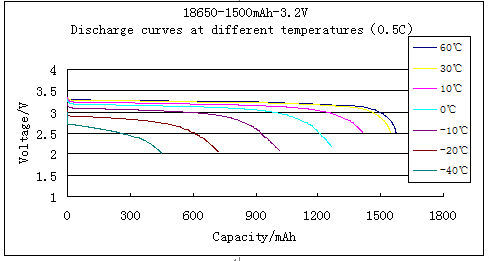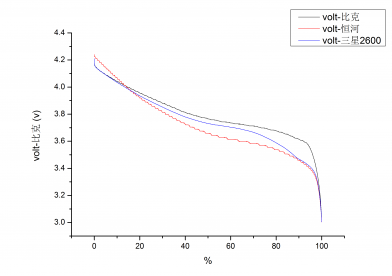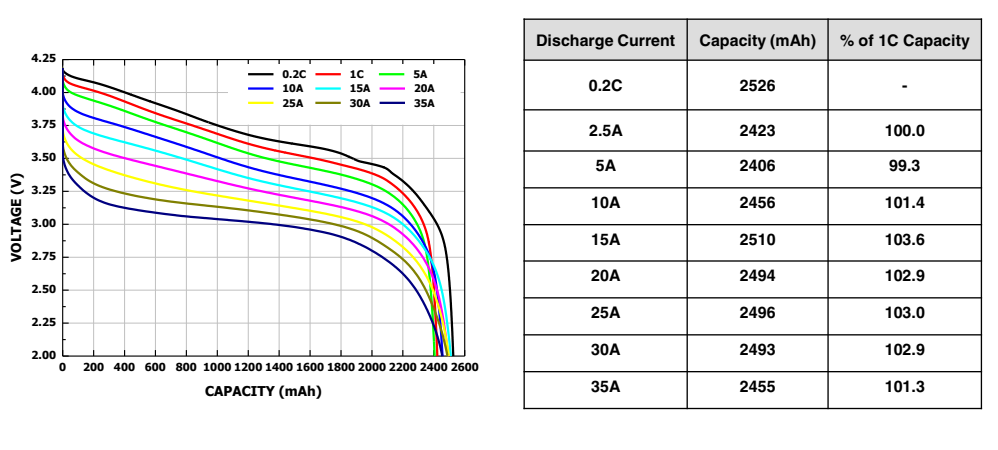-
1) What is a 18650 Rechargeable Battery?+
- How many types of 18650 batteries?
- Application of 18650 lithium battery
- 18650 Battery Voltage
- 18650 Battery Types
- Brand and model of 18650 lithium battery
- Panasonic 18650 battery model table
- LG 18650 battery model table
- Samsung 18650 battery model table
-
2) 18650 Battery Voltage Chart+
- Voltage diagram of 18650 battery at different temperatures:
-
3) 18650 Battery Voltage Curve
-
4) 18650 Battery Capacity Chart+
- 18650 battery capacity curve
-
5) How To Charge 18650 Battery
-
6) Can I Use AA Batteries Instead of 18650?
18650 Lithium Rechargeable Battery Pack
Mar 23, 2021 Pageview:5664
1) What is a 18650 Rechargeable Battery?
18650 battery is a general term for a kind of batteries, most of which now refers to 18650 lithium battery. 18650 means the external size of the battery, in which 18 represents the diameter of 18mm, 65 represents the length of 65mm, and 0 represents the cylindrical battery.
How many types of 18650 batteries?
There are 18650 nickel-metal hydride batteries, 18650 lithium ion batteries and 18650 lithium iron phosphate batteries.
Because of the material characteristics of 18650 NiMH batteries, they are inferior to lithium batteries in terms of energy density. In other words, under the same volume, the capacity density of lithium ion batteries is higher than that of nickel-metal hydride batteries. As a result, 18650 NiMH batteries are eliminated from the market. The most common 18650 batteries on the market now are lithium ion batteries
The 18650 lithium battery is divided into lithium ion battery and lithium iron phosphate battery. The nominal voltage of lithium ion battery is 3.7V, the charging cut-off voltage is 4.2V, the nominal voltage of lithium iron phosphate battery is 3.2V, the discharge cut-off voltage is 3.6V, the capacity is usually 1200mAh-3350mAh, and the common capacity is 2200mAh-2600mAh.
Application of 18650 lithium battery
1. Due to high capacity density, most of 18650 lithium ion batteries used for laptop batteries. In addition, 18650 battery has good stability, so it is widely used in the electronics field: commonly used in high-grade glare flashlight, portable power, wireless data transmission device, electric heating warm clothes/shoes, portable instrument, portable lighting, portable printers, industrial equipment, medical equipment, etc.
2. The 18650 lithium iron phosphate battery is mainly used in military equipment,special industry, deep-sea diving equipment, polar scientific investigation, power communication, public safety, medical electronics, AGV, RV, etc.
18650 Battery Voltage
The nominal voltage of a single unit of 18650 lithium battery is generally 3.6V/ 3.7V, the limited charge voltage is 4.20V, and the minimum discharge final voltage is generally 2.75V.
The minimum discharge final voltage of 18650 lithium batteries is generally 2.75V, below which the battery capacity may be seriously reduced or even scrapped. Most lithium batteries cannot discharge the no-load voltage below 3.2V, otherwise, the excessive discharge will damage the battery. Generally, lithium batteries in the market are only used with protective board, and the excessive discharge will also lead to the failure of the protective board to detect the battery, then the battery cannot be charged.
The maximum limiting voltage of 18650 lithium battery is 4.2V. It is generally believed that charging the no-load voltage of lithium battery to 4.2V is considered as full charge. During battery charging period, the battery voltage gradually rises to 4.2V from 3.7V. Don’t charge the no-load voltage above 4.2V, otherwise, the 18650 lithium battery will be damaged.
18650 Battery Types
Lithium is a metallic element. Why do we call it lithium battery? Because its positive electrode is lithium cobalt oxides. In fact, there are different kinds of batteries on the market now. They take lithium iron phosphate, lithium manganese as anode material. The nominal voltage of the 18650 lithium battery is 3.7V, the charging voltage is 4.20V, the minimum discharge final voltage is 2.75V, and the maximum charging final voltage is 4.20V.
Brand and model of 18650 lithium battery
18650 battery is the most commonly used battery in life and industry. No matter which lithium battery manufacturer, the size of 18650 lithium battery produced is certain. The difference is that the maximum capacity of the battery and the battery formula, resulting in different energy density ratio. The following is an introduction to the 18650 battery model specifications produced by several major lithium battery manufacturers, hoping to help you understand the characteristics and uses of this battery.
Panasonic 18650 battery model table
| model | CGR18650AF | CGR18650C | CGR18650CF | CGR18650D | CGR18650DA |
| nominal voltage | 3.6V | 3.6V | 3.6V | 3.6V | 3.6V |
| nominal capacity | 2050mAh | 2150mAh | 2250mAh | 2400mAh | 2450mAh |
| diameter | 18.6mm | 18.6mm | 18.6mm | 18.6mm | 18.6mm |
| Max height | 65.2mm | 65.2mm | 65.2mm | 65.2mm | 65.2mm |
| weight | 42g | 44.5g | 45g | 45g | 45.5g |
LG 18650 battery model table
| model | ICR18650P2 | ICR18650S2 | ICR18650A2 | ICR18650A3 | ICR18650B2 |
| nominal voltage | 2000mAh | 2200mAh | 2350mAh | 2430mAh | 2600mAh |
| nominal capacity | 3.7V | 3.7V | 3.7V | 3.7V | 3.6V |
| diameter | 18.3±0.1 | 18.3±0.1 | 18.3±0.1 | 18.3±0.1 | 18.3±0.1 |
| Max height | 64.9±0.2 | 64.8±0.2 | 64.8±0.2 | 64.8±0.2 | 64.9±0.2 |
| weight | 46.7g | 44.5g | 46.5g | 46.1g | 46.5g |
Samsung 18650 battery model table
| model | ICR18650-20 | ICR18650-22 | ICR18650-24 | ICR18650-26 |
| nominalvoltage | 2000mAh | 2200mAh | 2400mAh | 2600mAh |
| nominalcapacity | 3.7V | 3.7V±200mV | 3.7V | 3.7V |
| diameter | 18.25mm | 18.25mm | 18.25mm | 18.25mm |
| Maxheight | 65.0mm | 65.0mm | 65.0mm | 65.0mm |
| weight | 44g | 46g | 48g | 48g |
2) 18650 Battery Voltage Chart
Voltage diagram of 18650 battery at different temperatures:

The figure above describes the voltage curve of a single 3.2V/1500mAh 18650 lithium battery at different temperatures.
3) 18650 Battery Voltage Curve
In order to present the chemical characteristics of the material itself and reduce the effect of internal resistance, discharge the battery at 0.2C to 3.0V. To eliminate the influence of different discharge capacity, discharge capacity is replaced by discharge percentage.
As shown in the figure, Samsung 2600mah uses a material similar to 111 ternary anode material. The ratio of nickel-cobalt-manganese atoms for anode material is about 1:1:1.
Henhe 2200mah uses a similar 532 ternary anode material. The ratio of nickel-cobalt-manganese atoms for anode material is about 5:3:2.
The BAK 2,200 mah (18650C4) is a pure lithium cobalt acid anode. The positive electrode is all cobalt without nickel or manganese.
The picture below shows a very regular voltage curve.

Discharge voltage curves of three different types of lithium batteries
4) 18650 Battery Capacity Chart
18650 battery capacity curve
Test conditions - charging (charging current/charging voltage); charge the battery to 4.2V at 0.5C. Discharge cut-off current (charging current) is 100mA; cut-off voltage is 2.0V.

5) How To Charge 18650 Battery
1. High voltage charging: there is no special control circuit for this charging method. The battery with protective board is charged directly by a 5V power source, which completely relies on the high voltage limitation of the protective board.
2. Constant voltage charging: this method is similar to the previous one. Constant voltage is actually "limit voltage". Set a relatively accurate maximum voltage and then charge to the setting voltage.
3. Constant current charging: Control the maximum charging current. Constant current and constant voltage is actually "limited current and limited voltage ".
4. Intelligent charging: It is now considered to be an ideal charging management method. It follows the charging algorithm mentioned at the beginning of this section and is integrated in a small IC with simple, stable and reliable peripheral circuits, such as TP4054/4055/4056/4057, TP4002/5000, MAX1879 and so on. The main feature of this kind of chip is that it can monitor both voltage and current when judging whether fully charge or not. Stop charging when it is 4.2V, or when charging current is less than 0.01C (usually around 50mA). After charging, it will be completely stopped without floating charge, but the voltage will be monitored at any time. If the voltage of 18650 lithium battery drops to a certain value, charging will start again.
6) Can I Use AA Batteries Instead of 18650?
No. 5 battery (AA, R6) is one of the battery types. Its general size is 14mm in diameter and 50mm in height. Because of its small size and moderate capacity, AA battery is widely used in many small electrical appliances and digital products. AA battery cannot replace 18650 battery for the following reasons:
1. Different sizes. Although the 18650 and the AA battery look similar, their sizes are not the same. The size of the 18650 lithium battery is 18mm in diameter and 65mm in length. The AA battery (actually the scientific name of the AA battery is 14500 battery) has a diameter of 14mm and a length of 50mm. The 18650 is much larger in both length and diameter than the AA battery.
2. Different voltages. Lithium battery voltage is generally around 3.5~ 4.0V, the most common is 3.7V; AA battery has a voltage of 1.5V (non-rechargeable) or 1.2V (rechargeable).
3. Its working principle (internal chemical reaction process) is different.
4. The 18650 is a rechargeable battery. Most of the ordinary AA batteries are disposable batteries. Seldom of them are rechargeable ones.
Leave Message
Hottest Categories
-
Hottest Industry News
-
Latest Industry News










